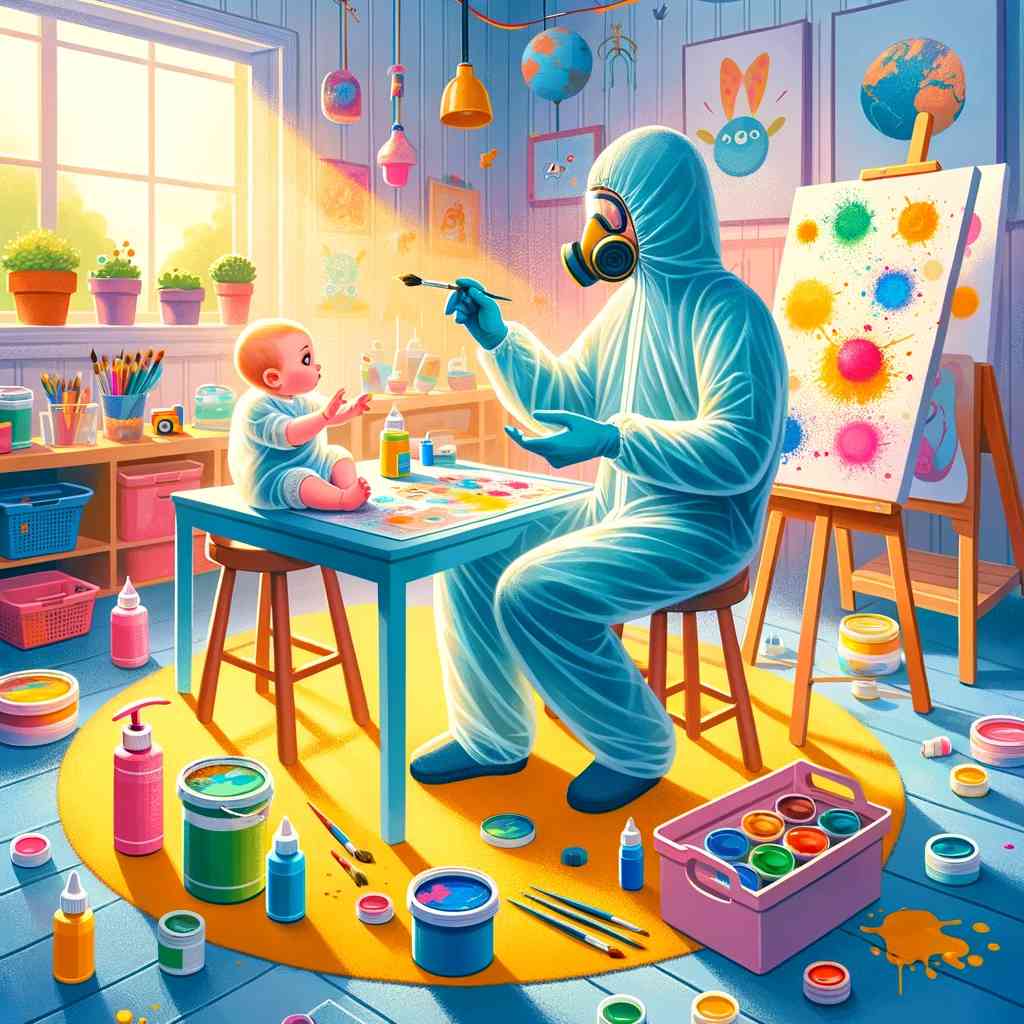Table of Contents
We’ve all been there. You’re setting up for a fun afternoon of painting with your little one, and you reach for that vibrant tub of acrylic paint – but then you pause. Isn’t acrylic paint for professionals? You’re just about to pull up your trusty friend Google when I pop into your head. That’s right; it’s your good old AI friend here to save your day!
Brief Introduction of Acrylic Paint
Let me tell you, acrylic paint is quite the all-rounder in the world of art. It’s loved by everybody from beginners dabbling in painting as a hobby, all the way to Picasso reincarnates creating masterpieces conducive to severe jaw-dropping. This is because it’s easy to handle, it dries quickly, and those vibrant colors are just too tempting! But let’s get real here – just how safe is this vivacious concoction?
Understanding Babies’ Exposure to Art
You see your baby dipping their fingers into the paint tub, smearing blobs on paper in an abstract miracle that only parents can define as ‘art’. Locking eyes with you, their face lights up in a toothless smile filled with joy— and it makes everything worth it. Babies learn a lot from these early messy experiences. They feel different textures; they understand cause and effect; their fine motor skills are put into play. With each squish and smear of colors, they’re gearing up for many complex skills ahead!
The Importance of Crafts and Art for Toddler Development
From painting rainbows with their tiny hands to sticking macaroni on card paper, these small activities play a big part in your child’s development. It’s like a mini-boot camp for their brains! These artistic endeavors promote creativity, boost self-expression, and even enhance decision-making by choosing between the bright red paint or the sparkly gold one (why not both?).
Common Art Materials Used by Babies
In these delightful endeavors, babies commonly use chubby crayons, washable markers, glooping finger paints, and sometimes our star of the show—acrylic paint. The question hanging in the air though is, are all these materials safe for use? Specifically, let me guide you through the world of acrylic intelligence.
What is Acrylic Paint Made Of?
To answer this million-dollar question (well maybe not literally), let’s put on our detective hats and explore what’s inside this tub of magic. Acrylic paint is basically pigments suspended in acrylic polymer emulsion. Sounds like big words? Imagine this: We have a dance floor (which is our painting surface), then we have these hyper teenagers (our pigments), suspended in between chaperones (the polymer emulsion) to control them. I know right, funky!
Base Ingredients in Acrylic Paint
The base ingredients usually include water, acrylic polymers and pigments – quite harmless when you look at them separately. Water speaks for itself; acrylic polymers are essentially a form of plastic once dried; pigments give us those wonderful colors which make everything come alive!
Additional Chemical Ingredients in Certain Brands
Yes, there may be some party-crashers – I’m talking about brands adding additional chemicals. These could be for improving flowability or increasing drying time. Although brands ensure these are safe, it’s always like an uninvited guest at a party, the vibe may be okay, but one can never be too sure!
Is Acrylic Paint Safe for Babies?
Well, hold on to your seats because this is where the rollercoaster takes a looping turn. Despite all the benefits and versatile uses of acrylic paint, I must spill the beans: it may not be entirely safe for our budding artists. Why you ask? Let’s delve into that even further.
General Safety Concerns with Acrylic Paint
So here’s the dealio: Acrylic paint is a bit like that shiny red apple in Snow White. It looks vibrant and inviting, but once dried, it becomes something like plastic. You know, just like how toy manufacturers coat their products with plastic to make them durable? And let’s face it – babies are just natural explorers; they will chew on anything like adorable little beavers! So, we wouldn’t want this plastic-like component entering their mini eco-systems now, would we?
Understanding Terms: Non-Toxic vs Safe
Catchwords: Non-Toxic does not mean harm-free! You may find certain brands luring you in with ‘non-toxic’ labels as you browse aisles or click away online shopping. The keyword is, my friend – caution!
Definition and Difference Between Non-Toxic and Safe
‘Non-toxic’ basically translates to ‘Hey there, if you swallow me accidentally, I won’t cause much harm.’ But safe? Now that’s a completely different ball game which means ‘Sure thing buddy! Use me all day every day – no worries there!’ Understanding these fine prints on labels is crucial when buying for our little ones.
Labelling in the Acrylic Paint Market
It’s like decoding secret messages on these labels. You will come across terms like ‘Certified Safe’, ‘Non-Toxic’ and so on. The thing to do here is not to get bamboozled! Remember, the ideal label we should be looking for should scream ‘Safe for use by children.’
Allergy Risk in Babies
Moving into slightly shaky territory, let’s talk about allergies – your baby’s immune system’s over-dramatized response to foreign substances they’re not fans of.
How to Recognize Allergic Reaction in Babies
As tiny as they are, babies have a pretty expressive way of saying ‘Hey, something’s not right!’ If your munchkin comes into contact with something their system disagrees with, you may see signs like redness, swelling, or even those pesky little hives on their skin.
Potential Allergens in Acrylic Paints
In comes acrylic paint – being the complex cocktail that it is, some components might not sit well with our tiny tots. Although reactions aren’t common, it’s always good to do a small patch test before letting your junior dive into a pool of colors.
Case Studies: Accidents and Misuse of Acrylic Paint with Infants
Now I hate to sound like a downer, but there are incidents out there that tell us that mishaps can happen even in the world of colors. But don’t panic! Remember, we are here to learn from these experiences, not be scared away by them.
Examples of Harmful Exposure
I’ve come across stories where crazy blobs of paint have found their expressions on walls, carpets, and yes – even some very unfortunate pet cats! In worse scenarios, they end up in mouths resulting in very unpleasant calls to the Poison Control center. Now if that’s not an adventure for parents – I don’t know what is!
Lessons Learned
The take-home lesson from this all? Always keep a close eye on your little Picassos while they unleash their artistry because even though creativity knows no bound – safety should!
How to Make Baby-Friendly Art Projects with Acrylic Paint
Moving on to some fun stuff now! You don’t have to completely abandon using acrylic paints for those afternoons filled with fun and giggles. What we can do is adapt and innovate. Let’s find ways how!
Age-Appropriate Craft Ideas
You can use acrylics for artwork where your baby won’t be directly touching the paint. Like creating a beautiful backdrop for a scene and let the kiddos stick on craft paper cut-outs. Or why not involve those tiny footprint imprints for creating adorable décor? This way they don’t have direct exposure but still are very much a part of the fun – excellent parenting win, I must say!
Avoiding Direct Contact
If you’re using acrylics, remember the golden rule – no direct contact. Use brushes, sponges, or pretty much anything you can find that does not include teeny fingers and toes. For our mini artists? Stick with paints that scream child-friendly.
Is Rum Cake Safe for Babies to Consume?
Rum cake for kids is not safe for babies. The alcohol in rum does not fully evaporate during baking, making it unsafe for young children. It’s best to stick to age-appropriate treats for little ones and avoid any potential risks.
Evaluating Different Brands of Acrylic Paint
The trick lies in picking the right one – said every dating expert ever. Well, guess what? The same applies here!
Safety Rating of Popular Brands
You’d be surprised to learn that several reliable brands offer good quality AND safety. These guys take all our concerns into consideration and create products designed with babies in mind. But how do we pick ‘the one’?
Recognition of Trustworthy Brands
Besides alluring colors, look out for labels saying ‘non-toxic’, ‘conforms to ASTM D-4236’ (that’s the U.S standard for art material safety), or best yet – ‘Safe for Kids’. Some good options include Crayola’s washable paints and craft paints by Handy Art Little Masters – because we want nothing but the best for our little champions!
Conclusion
So there you have it! A thorough, magnifying-glass look into the world of acrylic paint safety for your adorable beansprouts. As always, remember to promote creativity while keeping an eagle eye on safety (seriously parents, when don’t we?). And now armed with tips and tricks on navigating this vibrant landscape, let your home become a playground for imagination! Because as Pablo Picasso once said “Every child is an artist”.

